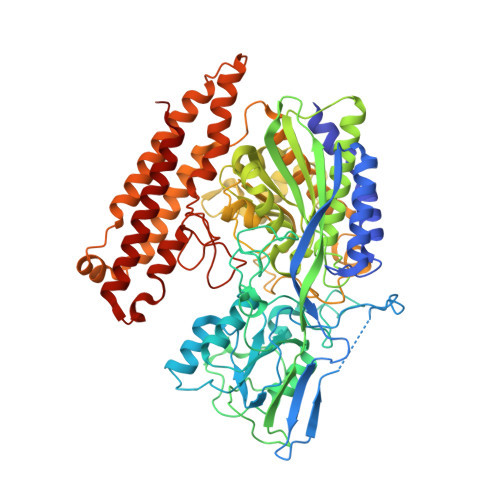Structural insight into the evolutionary and pharmacologic homology of glutamate carboxypeptidases II and III
Hlouchova, K., Barinka, C., Konvalinka, J., Lubkowski, J.(2009) FEBS J 276: 4448-4462
- PubMed: 19678840
- DOI: https://doi.org/10.1111/j.1742-4658.2009.07152.x
- Primary Citation of Related Structures:
3FEC, 3FED, 3FEE, 3FF3 - PubMed Abstract:
Glutamate carboxypeptidase III (GCPIII) is a metalloenzyme that belongs to the transferrin receptor/glutamate carboxypeptidase II (GCPII; EC 3.4.17.21) superfamily. GCPIII has been studied mainly because of its evolutionary relationship to GCPII, an enzyme involved in a variety of neuropathologies and malignancies, such as glutamatergic neurotoxicity and prostate cancer. Given the potential functional and pharmacological overlap between GCPIII and GCPII, studies addressing the structural and physiological properties of GCPIII are crucial for obtaining a deeper understanding of the GCPII/GCPIII system. In the present study, we report high-resolution crystal structures of the human GCPIII ectodomain in a 'pseudo-unliganded' state and in a complex with: (a) L-glutamate (a product of hydrolysis); (b) a phosphapeptide transition state mimetic, namely (2S,3'S)-{[(3'-amino-3'-carboxy-propyl)-hydroxyphosphinoyl]methyl}-pentanedioic acid; and (c) quisqualic acid, a glutamate biostere. Our data reveal the overall fold and quaternary arrangement of the GCPIII molecule, define the architecture of the GCPIII substrate-binding cavity, and offer an experimental evidence for the presence of Zn(2+) ions in the bimetallic active site. Furthermore, the structures allow us to detail interactions between the enzyme and its ligands and to characterize the functional flexibility of GCPIII, which is essential for substrate recognition. A comparison of these GCPIII structures with the equivalent GCPII complexes reveals differences in the organization of specificity pockets, in surface charge distribution, and in the occupancy of the co-catalytic zinc sites. The data presented here provide information that should prove to be essential for the structurally-aided design of GCPIII-specific inhibitors and might comprise guidelines for future comparative GCPII/GCPIII studies.
Organizational Affiliation:
Gilead Sciences and IOCB Research Centre, Institute of Organic Chemistry and Biochemistry, Academy of Sciences of the Czech Republic, Prague, Czech Republic.






















